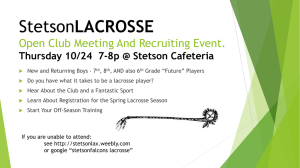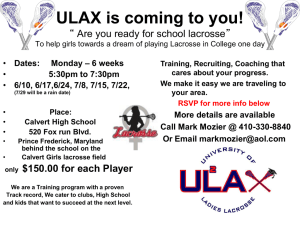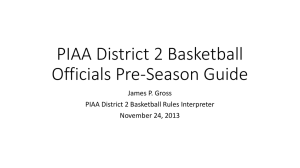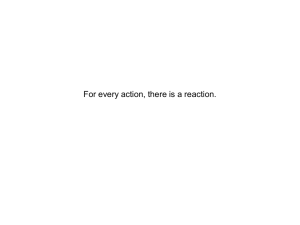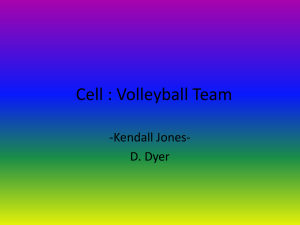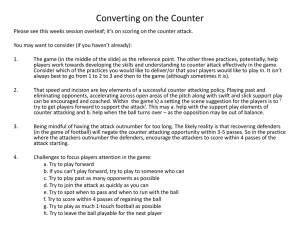2015 NFHS Men Lacrosse Rules Interpretation PowerPoint
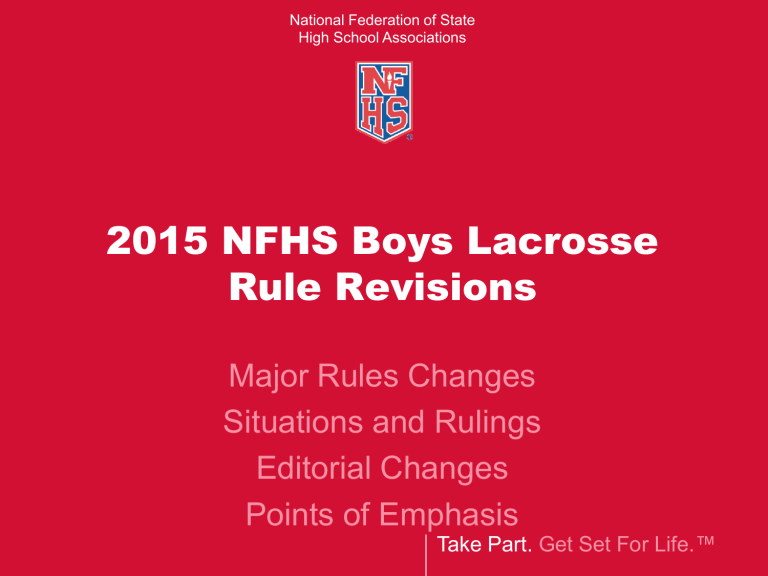
National Federation of State
High School Associations
2015 NFHS Boys Lacrosse
Rule Revisions
Major Rules Changes
Situations and Rulings
Editorial Changes
Points of Emphasis
Take Part. Get Set For Life.™
NFHS Boys Lacrosse Rules
Each state high school association adopting these
NFHS Boys Lacrosse Rules is the sole and exclusive source of binding rules interpretations for contests involving its member schools. Any person having questions about the interpretation of NFHS rules should contact the rules interpreter designated by his or her state high school association.
The NFHS is the sole and exclusive source of interpretations of NFHS rules. State rules interpreters may contact the NFHS for rules interpretations.
2015 Boys Lacrosse
11 Rule Changes were recommended by the Boys Lacrosse Rules Committee and approved by the NFHS Board of Directors.
National Federation of State
High School Associations
2015 NFHS Boys Lacrosse
Major Rules Changes
Take Part. Get Set For Life.™
Rule 1 Section 6 Article 2
Rule 1-6-2: With the ball in the crosse, horizontal to the ground at the deepest point of the pocket, tip the crosse forward
90 degrees to ensure that the ball rolls out of the top end of the head.
Rule 1-6-2
Rationale: With current stick specifications, a pocket can be strung in such a way that the ball will not easily roll out of the pocket, and could even completely prevent the ball from rolling out of the head. The two current stick field tests will not necessarily catch this. The addition of this procedure will assist officials in making the correct determination.
Rule 1 Section 7 Article 3
Rule 1-7-3: Any strings or leathers are limited to a hanging length of two inches. All hollow crosse handles must have their open end covered with an end cap manufactured for a lacrosse stick. In both cases, the crosse shall not be considered illegal; however, it shall be removed from the game until corrected.*( 2015 )
Rule 1-7-3
Rationale: To minimize risk and to be consistent with other rules codes. This revision will allow the ball to become dislodged more easily, thus lessening the risk of slashes and cross-checks currently used to dislodge the ball. This rule change creates more active play and improved passing. A picture was added to page 13 of the rules book to illustrate the details.
1-7-3 Delayed Implementation
Rule 1-7-3 - NFHS DELAYS 4 INCH STRING
RULE UNTIL 2016 .
• Concerning the crosse, any strings or leathers will be limited to a hanging length of 2 inches. In addition, any additional strings or laces (e.g., shooting strings,
V channels) must be located within 4 inches of the top of the crosse. No more than one sidewall string on each side is allowed.
Rule 2 Section 1 Article 3
Rule: 2-1-3: If, because of injuries, players out on ejection fouls, penalties or any other reason, a team cannot keep 10 players in the game, that team may continue the game with fewer than 10 players, with onside and stalling rules remaining in effect. However, a game shall not continue if a team has fewer than seven on-field players. The result of the game shall be determined by the state association or appropriate sponsoring authority.
Rule 2-1-3
Rationale: To minimize risk for the studentathletes the revision in Rule 2-1-3 states that a game no longer can be continued if a team has fewer than seven on-field players.
• The 2014 stacking rule stipulated that a team cannot play with fewer than 7 players because of penalties. That revision was adopted to minimize the risk involved in playing 7 on 10 in penalty situations. This revision will extend that concept to all situations when a team cannot put at least 7 players on the field.
Rule 2 Section 7 Article 1 & 2
Rule 2-7-1 & 2: When assigned by an assigning authority, an official acting as the chief bench official shall have supervision over the timer’s table and complete jurisdiction over the timer, scorer, coaches area and both benches. The chief bench official (CBO) shall wear the same uniform as the other officials and shall have a whistle, flag and horn. The horn shall be provided by the home team.
Rule 2-7-2
ART. 2: The CBO shall supervise and have complete jurisdiction over the timekeeper, penalty timekeepers, scorers, coaches, substitutes and any other persons within the bench areas, the substitution area and the penalty box.
Rule 2-7-1 & 2
The assigned chief bench official also shall be empowered to count crosses when requested and call the following: a. Violations of the coaches, bench and table area rules. b. Any unsportsmanlike acts that occur within the coaches, bench and table areas. c. Any illegal-crosse exchange.
d. A player who has been substituted for not leaving the field of play at the table area or bench area.
e. Offside. f. Too many or too few players on the field.
g. Delayed substitutions.
h. Time-outs.
i. Count crosses when requested.
j. Violations related to substitution.
Rule 2-7-1 & 2
If the CBO becomes aware of any of the listed infringements, they shall, depending on the circumstances, either throw a signal flag or blow their whistle, and apply the appropriate penalty.
Additionally, when the CBO becomes aware of a player committing an act of flagrant misconduct, then, if the act is away from the current area of play and is unlikely to have been seen by the onfield officials, the CBO shall either throw a signal flag or blow their whistle, as appropriate. When a whistle has stopped the play, the CBO shall inform the referee of what has happened and the
CBO shall make the appropriate call.
Rule 2-7-1 & 2
Rationale: More accurate description of the duties and authority of the Chief Bench
Official (CBO) and risk minimization.
• With the 2014 revision recommending that 3 officials be used, the Chief Bench Official will become more commonplace. This revision provides a more accurate description of the duties and authority of the Chief Bench
Official.
Rule 2 Section 10 Article 1
Rule 2-10-1 : The home team shall supply an adequate number of balls on each end line.
At the start of each period, a minimum of four balls should be spaced equal distance from each other five yards beyond the end lines and on the sideline opposite the benches. On the bench side, a minimum of four balls should be placed at the scorer’s table.
Rule 2-10-1
Rationale: Clarifies that the balls on the bench side are needed only at the table and not along the sideline.
Rule 3 Section 1 Article 2
3-1-2: After the first half, any time the score differential reaches 12 goals or more, starting with the whistle resuming play, the clock will only be stopped for a team timeout, official’s time-out or an injury time-out. If the score differential is reduced to fewer than 12 goals, then normal play will resume. All penalties that occur during a score differential situation will be running time. In this situation, running penalty time begins with the next whistle resuming play.
Rule 3-1-2
Rationale : More accurately stipulates when the running clock begins.
Rule 4 Section 22
Article 1 & 2 & 3& 4
Rule 4-22-1 : Once the official has signaled the ball ready for play, the official shall resume play within five seconds. Play may be resumed immediately after the ball is signaled ready for play if a player of the team awarded the ball is in position (see
Articles 2 and 3) outside the goal area and officials are in position to officiate the restart.
Rule 4-22-2
ART. 2 . . . Any violation on the defense that occurs while the ball is in the goal area will result in the ball being awarded to the offensive team laterally outside the goal area.
Rule 4-22-3
ART. 3 : Any violation on the offense that occurs while the ball is in the goal area will result in the ball being awarded to the defensive team. The defense may restart play with the ball in the goal area or in the crease .
Rule 4-22-4
ART. 4 : No restart shall take place with any player within 5 yards of the ball carrier.
Rule 4-22-4
Rationale: Risk Minimization. Allows the defense to restart more quickly and keeps the game moving.
Rule 5 Section 5
Rule 5.5
: A player may not use a crosse that does not conform to required specifications.
Use of an illegal crosse carries a one-or three-minute non-releasable penalty. A crosse found illegal due to a deep pocket will carry a one-minute non-releasable penalty.
Rule 5-5
A player using a crosse found illegal for not meeting any required specification other than a deep pocket will receive a three-minute non-releasable penalty
(exception: hanging string length and end caps as in Rule 1-7-3). A player using a crosse found illegal because it was altered to gain an advantage will receive a three-minute non-releasable penalty.
Rule 5-5
Any crosse ruled illegal and resulting in a three-minute penalty will remain in the table area for the remainder of the game.
Every crosse on a team is subject to inspection and the crosse need not have been in the game to be inspected.
Rule 5-5
Rationale: This clarifies that an illegal stick will result in a penalty for not meeting specifications, even if unaltered.
Rule 6 Section 4
Rule 6-4: No offensive player shall move into and make contact with a defensive player for the purpose of blocking a defensive player from the man he is playing, nor shall the offensive player hold his crosse rigid or extend his crosse rigid to impede the normal movements of the defensive player. If contact is made between offensive and defensive players as a result of the offensive player’s setting a screen, the offensive player shall be stationary before the contact occurs, with his feet no wider than shoulder-width apart.
Rule 6-4
Rationale: This provides consistency with other rule codes.
Rule 6 Section 5 Article 2e
6-5-2e: Entering the game from the penalty area before authorized to do so by the timekeeper. The player shall be returned to the penalty area to serve his remaining time, plus 30 seconds. If the ball is loose or in possession of the player’s own team, it shall be awarded to the opposing team and the player leaving the penalty area early does not have to serve an additional 30 seconds. In the event that a goal is scored by the opponent, the unexpired penalty time is nullified and the 30-second penalty is erased.
Rule 6-5-2e
Rationale: This provides consistency with other rule codes.
Rule 6 Section 5 Article 2w
Rule 6-5-2w: Take a dive or feign a slash to the head or body in order to deceive the official and draw a penalty.
Rule 6-5-2w
Rationale: This provides consistency with other rule codes.
National Federation of State
High School Associations
2015 NFHS Boys Lacrosse
Situations & Rulings
New or revised Situations and Rulings are preceded by an asterisk (*).
Take Part. Get Set For Life.™
*1.5 SITUATION C
* 1.5 SITUATION C:
The officials arrive at a game and find that the balls supplied by the home team include labeling that says “ Meets NOCSAE
Standard ” but the balls do not have the NFHS mark.
RULING: The officials begin the game using the balls supplied by the home team with no penalty to the home team and inform the state association or sponsoring authority after the conclusion of the game.
*1.5 SITUATION D
* 1.5 SITUATION D:
At some point after the start of the game, the officials determine that there are no balls available with the label “ Meets NOCSAE
Standard.
”
RULING: The game is suspended and the officials shall notify the sponsoring authority.
The sponsoring authority shall determine the result of the game or, if the game will be continued.
*1.10.1 SITUATION F
* 1.10.1 SITUATION F:
Player A has: (a) a small video camera attached to his helmet. (b) an electronic sensor on his arm which controls an off-field camera causing it to follow his movement on the field.
RULING: Both (a) and (b) are illegal.
COMMENT : Electronic devices attached to the helmet or worn by any of the 10 on-field players could cause injury to other players and are not allowed.
*2.1.3 SITUATION
*2.1.3 SITUATION:
Team B has fewer than seven players remaining due to penalties, injuries, ejections, etc.
RULING: Because Team B has fewer than seven players on the field, the game may not continue and it shall be reported to the sponsoring authority.
*2.6.1 SITUATION B
*2.6.1 SITUATION B:
The game officials arrive on the field 20 minutes prior to start of the game. (a) The officials have concerns whether the field is in playable condition; or (b) the head coach of the home or visiting team expresses concerns over whether the field is in playable condition and expresses these concerns to the officials.
RULING : In both (a) and (b), the referee approaches the home team’s game administration and expresses these concerns. The home team’s game administration, in consultation with the officials and both teams’ head coaches, makes the decision as to whether the field is in playable condition.
COMMENT: Prior to the start of the game, the home team’s game administration has the authority to determine if the field conditions are adequate to play the game. After the game begins, the officials have the authority to determine if the game should be delayed, suspended or terminated.
*4.7.1 SITUATION A
*4.7.1 SITUATION A:
Player A1 has the ball in the back of his crosse. (a) A1 attempts to pass, shoot or flip the ball out of the crosse and the ball stays in the crosse head when it should come out; (b) the back of
A1’s crosse faces the ground, but the ball defies gravity and does not fall out; (c) A1 hits his own stick with his hand or arm in order to dislodge the ball; (d) A1 kicks his own stick in order to dislodge the ball; (e) A1 hits the ground with the stick in order to dislodge the ball.
RULING: In all five cases, officials will rule that the ball is stuck in the head of the crosse because it is not coming out of the head with a normal lacrosse move. Immediate whistle, with possession awarded to the opponent ( withholding the ball from play ).
*4.8 SITUATION D
*4.8 SITUATION D:
Goalkeeper or any player in possession of the ball (a) brings his crosse back through the plane of his goal, or (b) brings his crosse back through the plane of his goal and the ball drops to the ground across the goal line.
RULING: (a) Legal play, no goal scored. (b) A goal is awarded to the opposing team.
COMMENT: When the player drops the ball in the goal, it is a loose ball beyond the plane of the goal.
*4.10 SITUATION I
*4.10 SITUATION I:
A1 is in the penalty box serving a penalty. Team A has either six players in its offensive half of the field or seven players in its defensive half of the field.
RULING: Team A is offside.
NOTE: For purposes of determining offside, player(s) serving penalties in the penalty box count as player(s) on the field.
*4.10 SITUATION J
*4.10 SITUATION J:
Team A has three players in the penalty box. During the face-off, the glove, foot or body of Team A’s face-off player is on or over the center line.
RULING: If the face-off player is down in the face-off position, he is considered to still be onside even though his glove, foot or body is on or over the center line. Once the face-off player is no longer down in the face-off position, normal offside rules apply.
*4.11 SITUATION
*4.11 SITUATION :
Team A has either started play or advanced the ball into its offensive half of the field when it is called for offside.
RULING: The ball shall be awarded to the offended team at the spot where the ball was when play was suspended. If the ball was in the goal area when play was suspended, it shall be restarted laterally outside the goal area nearest to the spot of the ball at the time of the whistle.
NOTE: This ruling is the result of the deletion of Rule 4-12 Articles 4 and 5 from the 2013 Rules Book .
*4.13 SITUATION C
*4.13 SITUATION C:
Team A is under a clearing 20-second count in the defensive half of the field when the ball becomes loose. Team B commits a technical violation and a play-on is called.
RULING : If Team A regains possession of the ball in the defensive end, the play-on is over and a new 20-second count starts.
*4.13 SITUATION D
*4.13 SITUATION D :
Team A goalkeeper is in his own crease while a 20-second count is underway, when
Team B commits a crease violation OR interferes with the goalkeeper.
RULING: A play-on situation. If Team A goalkeeper runs the ball out of the crease or completes an outlet pass, the play-on is over and a new 20-second count starts.
*4.13 SITUATION E
*4.13 SITUATION E:
Team A is clearing the ball in its defensive half of the field. The ball is loose when it crosses the center line. Before either team gains possession, the ball returns to
Team A’s defensive half of the field where
Team A regains possession.
RULING: Team A receives a new 20-second count.
*4.14.1 SITUATION E
*4.14.1 SITUATION E:
Team A is under a 10-second count when the ball becomes loose. Team B commits a technical violation and a play-on is called.
RULING: If Team A regains possession of the ball in the offensive end, the play-on is over and a new 10-second count starts.
*4.19.3 SITUATION B
*4.19.3 SITUATION B:
Goalkeeper B1, in the crease, makes a save. After three seconds, he deliberately (a) drops the ball, (b) flips the ball into the air and catches it again, or (c) flips the ball to B2 who is also in the crease.
RULING : Original four-second count continues in (a), (b), and (c).
*4.19.3 SITUATION D
*4.19.3 SITUATION D:
Goalkeeper B1 makes a save. After leaving the crease, B1 deliberately throws or tosses the ball back into the crease.
RULING : Loss of the ball to Team A.
*4.21 SITUATION
*4.21 SITUATION:
During a substitution, A1 delays his entrance onto the field. The trailing official sees the delay.
RULING: Silent playon, with an official’s arm in the air. If Team A gains an advantage by delaying the substitution, technical foul on Team A.
*7.2 SITUATION J
*7.2 SITUATION J:
During a live-ball situation, A1, A2, A3 and A4 or a coach from Team A are all called for releasable or non-releasable fouls.
RULING: If the officials can determine the order in which the fouls occurred, they shall be enforced in that order. If the officials cannot determine the order in which the fouls occurred, the most severe penalties shall be enforced first (up to three non-releasable penalties) and the fourth penalty shall be stacked and not served until one of the first three penalized players is released.
NOTE: In determining which penalties are more severe for this situation, non-releasable penalties are considered more severe than releasable penalties, regardless of length. If all penalties are of the same type, however, a longer penalty is considered more severe than a shorter one.
*7.2 SITUATION K
*7.2 SITUATION K:
During a live-ball situation, A1 and A2 are each assessed one-minute, non-releasable penalties, and A3 and A4 are each assessed one-minute releasable penalties. The officials cannot determine the order in which the fouls occurred. A1, A2 and A3 begin serving their penalties immediately, which makes Team A three players down. A4 waits in the bench area as the stacked player. After 28 seconds of the penalty time has elapsed, a goal is scored by Team B.
RULING : A3 is released and A4 begins serving his penalty time with
Team A still three players down. After 32 more seconds of penalty time has elapsed, A1 and A2 are both released and Team A is one player down. After 28 more seconds of penalty time has elapsed,
A4 is released and Team A is again at full strength.
National Federation of State
High School Associations
2015 NFHS Boys Lacrosse
Rule Revisions
Editorial Changes
Take Part. Get Set For Life.™
Mandatory Equipment
Editorial Revisions to Rules: 1-9-1, 1-9-3, 1-11-1, 5-
6, & 7-8-2g.
Replaced “ Mandatory Equipment ” for “Required
Equipment”.
Rationale: The term “mandatory equipment” is defined in the rule book but there are many places where the term “requirement equipment” is used. All instances of
“required equipment” have been replaced by
“mandatory equipment” for clarity.
Special Substitution
Editorial Revisions to Rules: 2-7-2 & 6-6-3.
Deleted the wording “ Special Substitutions ”.
Rationale: The concept of special substitution was removed in the 2014 rules however, there were some references to special substitution still in the rules.
Free Play/Restart
Editorial Revisions to Rules: 4-6-3a & 6-5-2i.
Deleted the wording “ free play ” from high school rules.
Rationale: Language changed from “free play” to restart in 2014 but there were still some instances of the term “free play” in the rules book.
NFHS Editorial Revision
Editorial Revision to 1-5.
Added the phrase “ at the time of manufacture ”.
Rationale: The manufacturer cannot control compliance with the NOCSAE standard after the time of manufacture.
NFHS Editorial Revision
Editorial Revision to Rule 1-9-1c.
Added the language “ protecting the anterior
(leading) dental arch ”.
Rationale: Clarification and recommendation from the NFHS Sports Medicine Advisory
Committee (SMAC) and from the Academy of
Sports Dentistry (ASD).
National Federation of State
High School Associations
2015 NFHS Boys Lacrosse
Points of Emphasis
Take Part. Get Set For Life.™
Points of Emphasis
Contact
Equipment Inspection
Lacrosse Helmet Fitting
NFHS Coaches Education
Contact
Contact – Boys lacrosse is a contact sport.
Checking and using the stick to dislodge the ball are integral parts of the game. The members of the NFHS Boys Lacrosse Rules
Committee value these strong traditions. The committee also understands the need to minimize risk of injury for all players. With the heightened awareness of the seriousness of concussion and other injuries, the committee realizes the need to take reasonable actions to reduce the risk of injury for all participants in the game of boys lacrosse.
Contact
Over the past few years, the NFHS Boys
Lacrosse Rules Committee has adopted several rules revisions regarding contact. The penalty for excessive hits to the head and neck has been revised in an effort to eliminate this type of contact from the game.
A section was also added to enhance penalties for hits to defenseless players and blindside hits. These revisions have had positive results to minimize the risk of injury.
Contact
The committee will continue to use the data collected by the NFHS Injury Surveillance
System and all other appropriate professional sources to identify areas of concern and then adopt rules revisions to address those concerns. It is incumbent upon coaches to teach the game consistent with the rules, for players to play the game within the rules and for officials to call the game according the rules.
Equipment Inspection
Equipment Inspection – It is recommended that officials, when conducting random equipment inspections during a game, ensure that they assess the legality of any players’ sticks, including those used for face-offs.
Lacrosse Helmet Fitting
Lacrosse helmets shall meet the current
NOCSAE standard and be properly fitted and worn. Padding of the helmet shall give firm and uniform pressure about the head.
The skin of the forehead should move as the helmet is moved from left to right and from front to back.
Lacrosse Helmet Fitting
There must be a four-point chin-strap attached to the helmet. The chin-strap should be tightened so that there is no slack. Properly fitted helmets must take into account the hairstyle of the player; if the player has a great deal of thick hair and then receives a haircut, the helmet must then be refitted. Proper helmet fit should never cause headaches.
Lacrosse Coaches Education
NFHS Coach Education - Lacrosse Courses www.nfhslearn.com
• Fundamentals of Coaching Boys Lacrosse
• Fundamentals of Coaching Girls Lacrosse
www.nfhslearn.com
Concussion in Sports – What You Need to Know
www.nfhslearn.com
FREE!
NFHS Sports Rules Books
Sports Nutrition
Role of the Parent in sports
Eligibility
Study skills
Youth Lacrosse Rules
A (Y) is included in numerous places throughout the book to indicate where the youth rules
( Rules for Boys Youth Lacrosse starting on page 97 ) differ from
NFHS rules.
For games played by younger age groups, age-specific rules should be utilized.
US Lacrosse has established such age-specific rules for youth play, which are contained in this book beginning on page 97.
NFHS Rules E-Books
NFHS Rules E-Books are now available for purchase.
Apple users can visit iTunes for available books.
Apple, Android and Kindle users can buy ebooks from Amazon.com and view them through the Kindle app.
Price: $5.99 each
Visit www.nfhs.org/ebooks for more information.
Important Dates
Date of 1st Practice: Monday, February 16 th
Date of 1st Contest: No earlier than
Monday, March 2 nd
Playoff Dates
Reporting Deadline: May 4 th (6 AM)
1
3 st
2 nd rd
Round:
Round:
Round:
May 6 th
May 8 th
May 12 th
4 th Round:
Regional:
State:
May 15 th
May 19 th
May 22 nd & 23 rd
Dead Periods
Fall: Aug. 1 st through Sept. 1 st
Winter: Oct. 29 th through Dec. 1 st
2015-16 Summer Dead Periods:
June 29 th - July 5 th
July 20 th - July 26 th
Board Approved Items
Any student-athlete who is ejected or disqualified from a contest is required to complete the NFHS Sportsmanship course before being eligible to return to competition.
All 64-team bracketed sports will be included in the seeding process for the 2014-15 academic year.
MaxPreps
Official Statistics Provider
• Records and standings for post-season qualifications
• 2014-15: MaxPreps Record = Official Record
• Incorrect record subject to DQ from playoffs
• All game results MUST be entered by Friday, May
4 th at 11:59 p.m.
• Triple check your record!
• Instructions can be found on the NCHSAA website
Qualifying for the Playoffs
Qualifiers
• Automatic
• Must finish 1,2 or 3 in straight conference, 1 or 2 in a split
• At Large
•
Based off highest 16-game winning percentage
Sportsmanship
The quality of responsible behavior characterized by a spirit of generosity and a genuine concern for opponents, officials and teammates.
Wholesome athletic environment
Good Sportsmanship > Victory
Modest in victory, gracious in defeat
Respecting judgment and integrity of game officials
Role modeling good behavior
Eligibility
Power Point
• Required viewing for all coaches
• Should be done with the athletic director
• Includes opportunities to discuss concussions/sudden cardiac arrests/Sickle Cell
Trait, etc.
Eligibility
Preseason Meeting
• Required attendance by all parents
• Time to share rules, regulations, expectations, philosophy etc.
• Time to get all required signatures--pledges,
Gfeller-Waller information, etc.
Clinic Attendance
Head coaches in football, soccer, volleyball, basketball, wrestling, swimming, baseball, softball, and track & field and lacrosse must attend an NCHSAA approved State Rules Clinic.
•
Must be completed prior to coaching in the first contest; subject to $400 fine, in addition to a $500 fine if he/she actually coaches in the contest
Coaches’ Education
NFHS Fundamentals of Coaching Course
• Currently, all non-faculty and newly hired coaches must take the Fundamentals of Coaching
Course; certificate of completion must be on file at the individual school
• Complete prior to first contest; subject to a $500 fine; continuing to coach without completion = another $500
• All coaches must have satisfied the requirement to take this course by August 1, 2015.
Coaches’ Education
Concussion Management Certification
• Effective August 1, 2014, the NFHS Concussion
Course (free on-line course) or an equivalent course must be completed by all coaches
• Prior to the first date of practice for that sport ; subsequently, the certificate of completion must be on file at the individual school; subject to $500 fine
Coaches’ Education
“Education is a journey, not a destination”
Coaches’ Education
• Accredited Interscholastic Coach
(AIC)
• Requires completion of 4 courses:
–Fundamentals of Coaching
–1 st Aid, Health & Safety for Coaches
–Sport Specific Course or Teaching
Sports Skills
–Concussion in Sports (Free)
Coaches’ Education
• Certified Interscholastic Coach (CIC)
• Completion of AIC requirements
• Plus:
–Teaching & Modeling Behavior
–Engaging Effectively with Parents
–Sportsmanship
–Creating a Safe and Respectful
Environment
–Strength & Conditioning
–2 additional courses (User Choice)
Sportsmanship
Teaching & Modeling Behavior
Course
• Required for any coach ejected during a contest
• Required for any coach who has player (s) ejected for fighting
NFHS Sportsmanship Course
• Replaces the Star Sportsmanship Course for any ejected/disqualified player
• Free, on-line course (nfhslearn.com)
• All certificates must be sent to NCHSAA
Gfeller-Waller Concussion Law
Requirements of the Law:
• Concussion signs and symptoms
•
Given prior to participation
• Parents/athletes sign indicating “receipt of”
• Return to Play (RTP) form signed by a physician licensed to practice medicine
When in doubt, sit them out ”
• An up-to-date Emergency Action Plan (EAP)
• Must be on-file
• Must be posted
• Must be updated annually
National Federation of State
High School Associations
2015 NFHS Boys Lacrosse
Rule Presentation
Thank you for your participation!
Take Part. Get Set For Life.™
